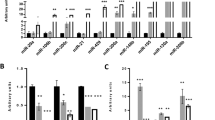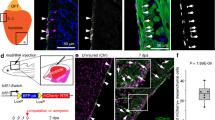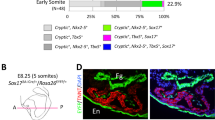Abstract
ES-cell-based cardiovascular repair requires an in-depth understanding of the molecular mechanisms underlying the differentiation of cardiovascular ES cells. A candidate cardiovascular-fate inducer is the bHLH transcription factor MesP11,2. As one of the earliest markers, it is expressed specifically in almost all cardiovascular precursors and is required for cardiac morphogenesis2,3. Here we show that MesP1 is a key factor sufficient to induce the formation of ectopic heart tissue in vertebrates and increase cardiovasculogenesis by ES cells. Electrophysiological analysis showed all subtypes of cardiac ES-cell differentiation4. MesP1 overexpression and knockdown experiments revealed a prominent function of MesP1 in a gene regulatory cascade, causing Dkk-1-mediated blockade of canonical Wnt-signalling. Independent evidence from ChIP and in vitro DNA-binding studies, expression analysis in wild-type and MesP knockout mice, and reporter assays confirm that Dkk-1 is a direct target of MesP1. Further analysis of the regulatory networks involving MesP1 will be required to preprogramme ES cells towards a cardiovascular fate for cell therapy and cardiovascular tissue engineering. This may also provide a tool to elicit cardiac transdifferentiation in native human adult stem cells.
This is a preview of subscription content, access via your institution
Access options
Subscribe to this journal
Receive 12 print issues and online access
$209.00 per year
only $17.42 per issue
Buy this article
- Purchase on Springer Link
- Instant access to full article PDF
Prices may be subject to local taxes which are calculated during checkout





Similar content being viewed by others
References
Saga, Y. et al. MesP1 is expressed in the heart precursor cells and required for the formation of a single heart tube. Development 126, 3437–3447 (1999).
Saga, Y., Kitajima, S. & Miyagawa-Tomita, S. MesP1 expression is the earliest sign of cardiovascular development. Trends Cardiovasc. Med. 10, 345–352 (2000).
Kitajima, S., Miyagawa-Tomita, S., Inoue, T., Kanno, J. & Saga, Y. MesP1-nonexpressing cells contribute to the ventricular cardiac conduction system. Dev. Dyn. 235, 395–402. (2006).
Maltsev, V. A., Wobus, A. M., Rohwedel, J., Bader, M. & Hescheler, J. Cardiomyocytes differentiated in vitro from embryonic stem cells developmentally express cardiac-specific genes and ionic currents. Circ. Res. 75, 233–244. (1994).
Nir, S. G., David, R., Zaruba, M., Franz, W. M. & Itskovitz-Eldor, J. Human embryonic stem cells for cardiovascular repair. Cardiovasc. Res. 58, 313–323 (2003).
David, R., Groebner, M. & Franz, W. M. Magnetic cell sorting purification of differentiated embryonic stem cells stably expressing truncated human CD4 as surface marker. Stem Cells 23, 477–482 (2005).
Saga, Y. et al. MesP1: a novel basic helix-loop-helix protein expressed in the nascent mesodermal cells during mouse gastrulation. Development 122, 2769–2678 (1996).
Satou, Y., Imai, K. S. & Satoh, N. The ascidian MesP gene specifies heart precursor cells. Development. 131, 2533–2541. (2004).
Davidson, B., Shi, W. & Levine, M. Uncoupling heart cell specification and migration in the simple chordate Ciona intestinalis. Development 132, 4811–4818 (2005).
Wobus, A. M. et al. Retinoic acid accelerates embryonic stem cell-derived cardiac differentiation and enhances development of ventricular cardiomyocytes. J. Mol. Cell. Cardiol. 29, 1525–1539 (1997).
Kanno, S. et al. Nitric oxide facilitates cardiomyogenesis in mouse embryonic stem cells. Proc. Natl Acad. Sci. USA 101, 12277–12281 (2004).
Schroeder, T. et al. Recombination signal sequence-binding protein Jκ alters mesodermal cell fate decisions by suppressing cardiomyogenesis. Proc. Natl Acad. Sci. USA 100, 4018–4023 (2003).
Tillet, E. et al. N-cadherin deficiency impairs pericyte recruitment, and not endothelial differentiation or sprouting, in embryonic stem cell-derived angiogenesis. Exp. Cell Res. 310, 392–400 (2005).
Kinder, S. J. et al. The organizer of the mouse gastrula is composed of a dynamic population of progenitor cells for the axial mesoderm. Development 128, 3623–3634 (2001).
Weinmann, A. S. & Farnham, P. J. Identification of unknown target genes of human transcription factors using chromatin immunoprecipitation. Methods 26, 37–47 (2002).
Izumi, N., Era, T., Akimaru, H., Yasunaga, M. & Nishikawa, S. Dissecting the molecular hierarchy for mesendoderm differentiation through a combination of embryonic stem cell culture and RNA interference. Stem Cells 25, 1664–1674 (2007).
Sakurai, H. et al. In vitro modeling of paraxial and lateral mesoderm differentiation reveals early reversibility. Stem Cells 24, 575–586 (2006).
Liu, Y. et al. Sox17 is essential for the specification of cardiac mesoderm in embryonic stem cells. Proc. Natl Acad. Sci. US. 104, 3859–3864 (2007).
Kitajima, S., Takagi, A., Inoue, T. & Saga, Y. MesP1 and MesP2 are essential for the development of cardiac mesoderm. Development 127, 3215–3226 (2000).
Foley, A. C. & Mercola, M. Heart induction by Wnt antagonists depends on the homeodomain transcription factor Hex. Genes Dev. 19, 387–396 (2005).
Klaus, A., Saga, Y., Taketo, M. M., Tzahor, E. & Birchmeier, W. Distinct roles of Wnt/β-catenin and Bmp signalling during early cardiogenesis. Proc. Natl Acad. Sci. USA 104, 18531–18536 (2007).
Schneider, V. A. & Mercola, M. Wnt antagonism initiates cardiogenesis in Xenopus laevis. Genes Dev. 15, 304–315 (2001).
Eisenberg, L. M. & Eisenberg, C. A. Wnt signal transduction and the formation of the myocardium. Dev. Biol. 293, 305–315 (2006).
Jaspard, B., Couffinhal, T., Dufourcq, P., Moreau, C. & Duplaa, C. Expression pattern of mouse sFRP-1 and mWnt-8 gene during heart morphogenesis. Mech. Dev. 90, 263–267 (2000).
Reiter, J. F. et al. Gata5 is required for the development of the heart and endoderm in zebrafish. Genes Dev. 13, 2983–2995 (1999).
David, R., Joos, T. O. & Dreyer, C. Anteroposterior patterning and organogenesis of Xenopus laevis require a correct dose of germ cell nuclear factor (xGCNF). Mech. Dev. 79, 137–152. (1998).
Weintraub, H. et al. The myoD gene family: nodal point during specification of the muscle cell lineage. Science 251, 761–766 (1991).
Muller, M. et al. Selection of ventricular-like cardiomyocytes from ES cells in vitro. Faseb J. 14, 2540–2548 (2000).
Stieber, J. et al. The hyperpolarization-activated channel HCN4 is required for the generation of pacemaker action potentials in the embryonic heart. Proc. Natl Acad. Sci. USA 100, 15235–15240 (2003).
Acknowledgements
We are very grateful for expert technical assistance from Christiane Gross who is funded by the Deutsche Forschungsgemeinschaft (DFG; FR 705/11-3) and the Fritz-Bender-Stiftung. We are also very grateful to Frank Ebel (Max-von-Pettenkofer-Institut, Munich) for helping with the laser scanning microscopy experiments. R.D. is funded exclusively by the DFG (FR 705/11-3). C.B. and F.S. is funded by the FöFoLe program of the LMU Munich. H.L. is supported by an Emmy-Noether Fellowship of the DFG. Additional funding was granted by the Helmut Legalotz-Stiftung for FACS and consumables. We thank Christof Niehrs for the mouse Dkk-1 in situ probe and Yumiko Saga for providing us with the MesP1/2 dK.O. embryos.
Author information
Authors and Affiliations
Contributions
R. D. designed the experiments together with W.-M. F. and performed promoter studies; J. M.-H. perfromed the electron mcroscoy analyses; R. R., R. D. and E. M. performed the Xenopus experiments; R. D. and C. B. performed the molecular cloning and ES cell experiments, and RT-PCR; C. B., F. S. and S. B. performed the FACS and immunostaining; J. S. performed the electrophysiological studies; H. L., M. V. and S. K. performed the wild-type and knockout in situ hybridization studies.
Corresponding authors
Supplementary information
Supplementary Information
Supplementary figures S1, S2, S3, S4, S5, S6, Movie legends, Supplementary table S1 and Methods (PDF 1596 kb)
Supplementary Information
Supplementary Movie 1 (WMV 478 kb)
Supplementary Information
Supplementary Movie 2 (WMV 207 kb)
Supplementary Information
Supplementary Movie 3 (WMV 263 kb)
Supplementary Information
Supplementary Movie 4 (WMV 378 kb)
Supplementary Information
Supplementary Movie 5 (MPG 5081 kb)
Supplementary Information
Supplementary Movie 6 (MPG 4761 kb)
Rights and permissions
About this article
Cite this article
David, R., Brenner, C., Stieber, J. et al. MesP1 drives vertebrate cardiovascular differentiation through Dkk-1-mediated blockade of Wnt-signalling. Nat Cell Biol 10, 338–345 (2008). https://doi.org/10.1038/ncb1696
Received:
Accepted:
Published:
Issue Date:
DOI: https://doi.org/10.1038/ncb1696
This article is cited by
-
Mesp1 controls the chromatin and enhancer landscapes essential for spatiotemporal patterning of early cardiovascular progenitors
Nature Cell Biology (2022)
-
Basal Cells in the Epidermis and Epidermal Differentiation
Stem Cell Reviews and Reports (2022)
-
Wnt Signaling in Heart Development and Regeneration
Current Cardiology Reports (2022)
-
Soluble expression, purification, and secondary structure determination of human MESP1 transcription factor
Applied Microbiology and Biotechnology (2021)
-
MESP2 variants contribute to conotruncal heart defects by inhibiting cardiac neural crest cell proliferation
Journal of Molecular Medicine (2020)



